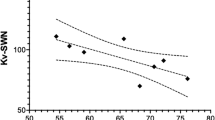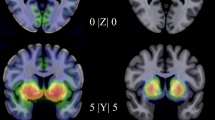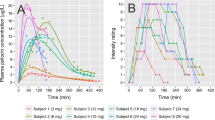Abstract
Rationale
The beneficial effects of psychostimulant drugs in the treatment of psychiatric disorders occur because they increase the extracellular dopamine concentration by inhibiting re-uptake of extracellular dopamine at dopamine transporters. However, the psychological effects at low dopamine transporter occupancy have not been well demonstrated.
Objectives
The purpose of the study was to evaluate the psychological effects, dopamine transporter occupancy, and dopamine release induced by a single oral administration of a clinical dose of mazindol.
Methods
Ten healthy male volunteers were orally administered a placebo and a clinical dose of mazindol (1.5 mg) on separate days. The psychological effects of mazindol were assessed using a visual analogue scale to detect alterations in the state of consciousness. The amount of blockade of dopamine transporters was assessed using positron emission tomography with [18F]FE-PE2I and extracellular dopamine release was measured as the amount of change in [11C]raclopride binding.
Results
Following administration of a clinical dose of mazindol, the dopamine transporters were blocked by 24–25 %, and the binding potential of [11C]raclopride was reduced by 2.8–4.6 %. The differences of a score measuring derealisation and depersonalization associated with a positive basic mood were significantly correlated with the change in the [11C]raclopride binding in the limbic striatum.
Conclusions
A subtle alteration in the state of consciousness was detected with a correlation to the changes in the [11C]raclopride binding, which implies that a subtle alteration in extracellular dopamine concentration in the limbic striatum by a small amount of dopamine transporter occupancy can affect the state of consciousness.
Trial registration https://upload.umin.ac.jp/cgi-open-bin/ctr_e/ctr_view.cgi?recptno=R000009703
UMIN000008232

Similar content being viewed by others
References
Chait LD, Uhlenhuth EH, Johanson CE (1986) The discriminative stimulus and subjective effects of phenylpropanolamine, mazindol and d-amphetamine in humans. Pharmacol Biochem Behav 24:1665–1672
Chait LD, Uhlenhuth EH, Johanson CE (1987) Reinforcing and subjective effects of several anorectics in normal human volunteers. J Pharmacol Exp Ther 242:777–783
Coakley JH, Edwards RH, Moorcraft J et al (1988) Mazindol in Duchenne muscular dystrophy. Lancet 1:184
Delaet D, Schauer D (2011) Obesity in adults. BMJ Clin Evid 03:604
Dittrich A (1994) Psychological aspects of altered states of consciousness of the LSD type: measurements of their basic dimensions and prediction of individual differences. In: Pletscher A, Ladewig D (eds) 50 years of LSD. Current status and perspectives of hallucinogens. Pletscher A, New York, pp. 101–118
Dittrich A (1998) The standardized psychometric assessment of altered states of consciousness (ASCs) in humans. Pharmacopsychiatry 31(Suppl 2):80–84
Drevets WC, Gautier C, Price JC et al (2001) Amphetamine-induced dopamine release in human ventral striatum correlates with euphoria. Biol Psychiatry 49:81–96
Engstrom RG, Kelly LA, Gogerty JH (1975) The effects of 5-hydroxy-5(4′-chlorophenyl)-2, 3-dihydro-5H-imidazo (2, 1-a) isoindole (mazindol, SaH 42-548) on the metabolism of brain norepinephrine. Arch Int Pharmacodyn Ther 214:308–321
Gatley SJ, Volkow ND, Gifford AN et al (1997) Model for estimating dopamine transporter occupancy and subsequent increases in synaptic dopamine using positron emission tomography and carbon-11-labeled cocaine. Biochem Pharmacol 53:43–52
Ichise M, Liow J-S, Lu J-Q et al (2003) Linearized reference tissue parametric imaging methods: application to [11C]DASB positron emission tomography studies of the serotonin transporter in human brain. J Cerebr Blood F Met 23:1096–1112
Kodaka F, Ito H, Kimura Y et al (2013) Test-retest reproducibility of dopamine D2/3 receptor binding in human brain measured by PET with [11C]MNPA and [11C]raclopride. Eur J Nucl Med Mol Imaging 40:574–579
Koepp MJ, Gunn RN, Lawrence AD et al (1998) Evidence for striatal dopamine release during a video game. Nature 393:266–268
Konofal E, Zhao W, Laouenan C et al (2014) Pilot phase II study of mazindol in children with attention deficit/hyperactivity disorder. Drug Des Devel Ther 8:2321–2332
Laruelle MA (2000) Imaging synaptic neurotransmission with in vivo binding competition techniques: a critical review. J Cerebr Blood F Met 20:423–451
Malison RT, McCance E, Carpenter LL et al (1998) [123I]β-CIT SPECT imaging of dopamine transporter availability after mazindol administration in human cocaine addicts. Psychopharmacology 137:321–325
Nakajima N, Hayashi H, Takahashi K et al (1986) Chronic toxicity test of mazindol in rats by oral 26-week administration. Clin Rep (JPN) 20:2243–2278
Nittur N, Konofal E, Dauvilliers Y et al (2013) Mazindol in narcolepsy and idiopathic and symptomatic hypersomnia refractory to stimulants: a long-term chart review. Sleep Med 14:30–36
Preston KL, Sullivan JT, Berger P, Bigelow GE (1993) Effects of cocaine alone and in combination with mazindol in human cocaine abusers. J Pharmacol Exp Ther 267:296–307
Sakayori T, Tateno A, Arakawa R et al (2014) Effect of mazindol on extracellular dopamine concentration in human brain measured by PET. Psychopharmacology 231:2321–2325
Tsukada H, Nishiyama S, Kakiuchi T et al (1999) Is synaptic dopamine concentration the exclusive factor which alters the in vivo binding of [11C]raclopride?: PET studies combined with microdialysis in conscious monkeys. Brain Res 841:160–169
Tziortzi AC, Haber SN, Searle GE et al (2014) Connectivity-based functional analysis of dopamine release in the striatum using diffusion-weighted MRI and positron emission tomography. Cereb Cortex 24:1165–1177
Volkow ND, Wang GJ, Fischman MW et al (1997) Relationship between subjective effects of cocaine and dopamine transporter occupancy. Nature 386:827–830
Volkow ND, Wang G-J, Fowler JS et al (2002) Relationship between blockade of dopamine transporters by oral methylphenidate and the increases in extracellular dopamine: therapeutic implications. Synapse 43:181–187
Volkow ND, Fowler JS, Logan J et al (2009) Effects of modafinil on dopamine and dopamine transporters in the male human brain: clinical implications. JAMA 301:1148–1154
Vollenweider FX, Vollenweider-Scherpenhuyzen MF, Bäbler A et al (1998) Psilocybin induces schizophrenia-like psychosis in humans via a serotonin-2 agonist action. Neuroreport 9:3897–3902
Vollenweider FX, Vontobel P, Hell D, Leenders KL (1999) 5-HT modulation of dopamine release in basal ganglia in psilocybin-induced psychosis in man--a PET study with [11C]raclopride. Neuropsychopharmacology 20:424–433
Yanagida T, Wakasa Y, Oinuma N (1982) Drug dependence potential of mazindol tested in rhesus monkeys. Gent Inst Exp Anim Preclin Rep (JPN) 8:247–257
Acknowledgments
We thank Takahiro Shiraishi, Hironobu Fujiwara, Fumitoshi Kodaka, Harumasa Takano, and the other members of the Clinical Neuroimaging Team for their support with the PET scans, Izumi Kaneko-Izumida for the preparation of mazindol and the placebo, Kazuko Suzuki for assistance as the clinical research coordinator, Mika Omatsu, Hiromi Sano, and Takako Aoki for performing MRI scanning, and the staff of the Molecular Probe Program for the successful preparation of the radioligands.
This study was partly supported by the Brain Mapping by Integrated Neurotechnologies for Disease Studies (Brain/MINDS) from the Japan Agency for Medical Research and Development, AMED.
Author information
Authors and Affiliations
Corresponding author
Ethics declarations
The study was approved by the Ethics and Radiation Safety Committee of the National Institute of Radiologic Sciences, Chiba, Japan and was performed in accordance with the ethical standards laid down in the 1964 Declaration of Helsinki and its later amendments. Written informed consent was obtained from all subjects before their inclusion in the study.
Conflict of interest
The authors declare that they have no competing interests.
Rights and permissions
About this article
Cite this article
Kimura, Y., Maeda, J., Yamada, M. et al. Measurement of psychological state changes at low dopamine transporter occupancy following a clinical dose of mazindol. Psychopharmacology 234, 323–328 (2017). https://doi.org/10.1007/s00213-016-4464-x
Received:
Accepted:
Published:
Issue Date:
DOI: https://doi.org/10.1007/s00213-016-4464-x




